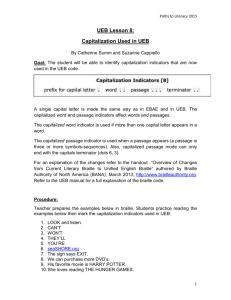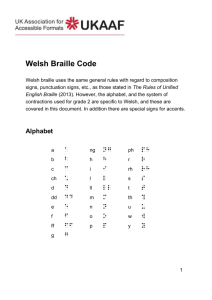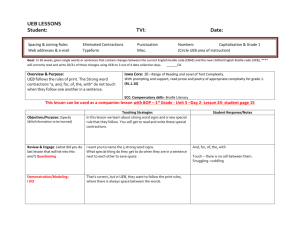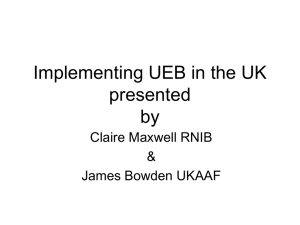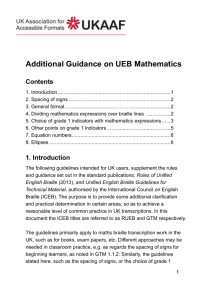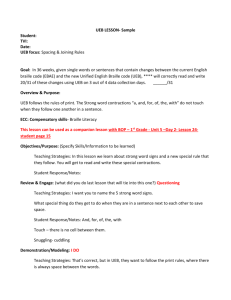UEB Summary (uncontracted doc)
advertisement
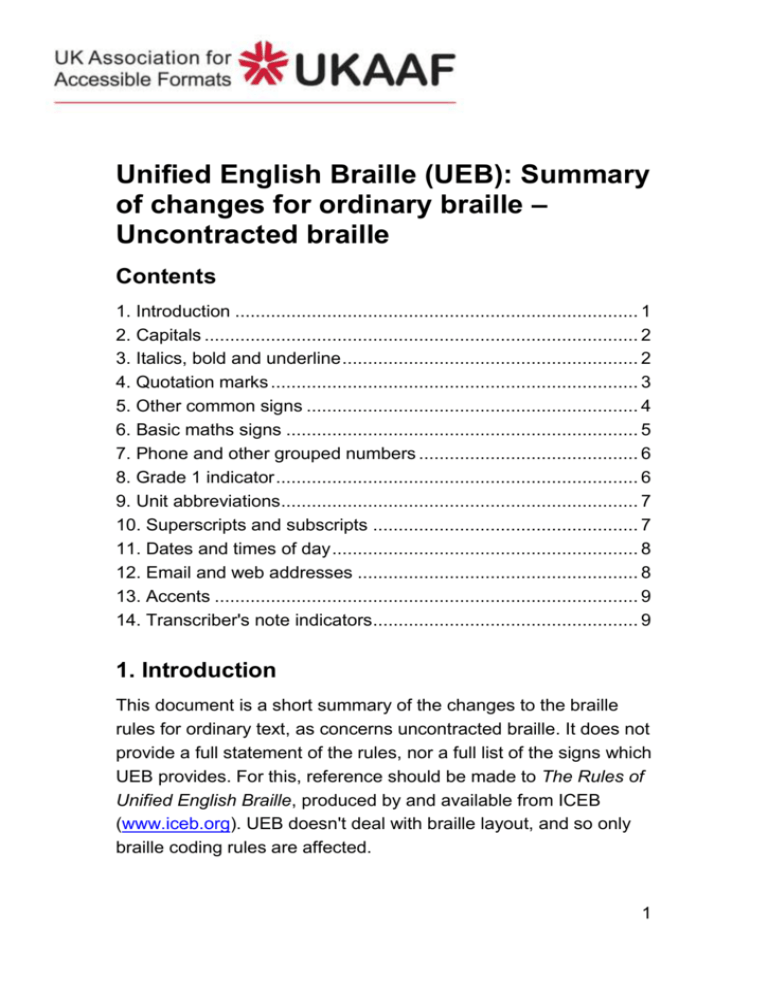
UKAAF Logo UK Association for Accessible Formats Unified English Braille (UEB): Summary of changes for ordinary braille – Uncontracted braille Contents 1. Introduction ............................................................................... 1 2. Capitals ..................................................................................... 2 3. Italics, bold and underline .......................................................... 2 4. Quotation marks ........................................................................ 3 5. Other common signs ................................................................. 4 6. Basic maths signs ..................................................................... 5 7. Phone and other grouped numbers ........................................... 6 8. Grade 1 indicator ....................................................................... 6 9. Unit abbreviations...................................................................... 7 10. Superscripts and subscripts .................................................... 7 11. Dates and times of day ............................................................ 8 12. Email and web addresses ....................................................... 8 13. Accents ................................................................................... 9 14. Transcriber's note indicators .................................................... 9 1. Introduction This document is a short summary of the changes to the braille rules for ordinary text, as concerns uncontracted braille. It does not provide a full statement of the rules, nor a full list of the signs which UEB provides. For this, reference should be made to The Rules of Unified English Braille, produced by and available from ICEB (www.iceb.org). UEB doesn't deal with braille layout, and so only braille coding rules are affected. 1 2. Capitals Capitals are normally indicated. The indicators are the same as for SEB: Capital indicator symbol word passage terminator , ,, ,,, ,' The rules are generally similar to those for SEB: the capital word indicator has force over a sequence of letters or contractions, but is terminated by other signs, such as a hyphen or dash. The capital passage indicator applies up to the capital terminator, and is used for three or more spaced strings (e.g. words). ,,left-,,hand ,,,I am "here6,' E.g. LEFT-HAND I AM HERE! 3. Italics, bold and underline There are separate indicators for italics, bold and underline. In UEB these are collectively called "typeform indicators": symbol word passage terminator Italic Bold Underline .2 .1 .7 .' ^2 ^1 ^7 ^' _2 _1 _7 _' 2 The symbol indicators apply to the following character only; the word indicators apply to the following string ending with a space (e.g. a word); and the passage indicators apply up to the corresponding passage terminators. E.g. books Reading The Times book^2s reading .1,the .1,times .1avant-garde avant-garde The passage indicators are used for three or more consecutive spaced strings (e.g. words) of that type. If punctuation ends the passage, the terminator is normally placed after it. E.g. Guide to the Tower of London. ,guide to the ^7,tower of ,london4^' 4. Quotation marks Outer quotation marks have generic braille signs whatever the print type (single or double), but inner quotes use new signs which distinguish between single and double print quotes. The latter can also be used in other circumstances where it is needed to distinguish the type of print quotes. outer inner single ' ' inner double " " Open Close 8 ,8 ^8 0 ,0 ^0 3 E.g. 'He asked, "Can I come in?" ' 8,he asked1 ^8,can ,I come in8^00 5. Other common signs round brackets ( ) opening "< closing "> square brackets [ ] opening .< closing .> asterisk * dagger † "9 @,? double dagger ‡ dash – @,] ,",_ .- (e.g. a blank to be filled in; the single braille long dash — underscore sign is used for any length of underscore in print) 4 (i.e. same as full stop) ellipsis … 444 (i.e. a sequence of stops) pound sign £ @l dollar sign $ @s degree sign ° ^j prime ′ 7 (e.g. feet or minutes) double prime ″ 77 (e.g. inches or seconds) percent % .0 commercial at @ @a right arrow → \o decimal point . 4 UEB is designed so that all the signs are capable of being spaced or unspaced in any combination without ambiguity, so arbitrary strings of letters and other signs can be brailled directly as shown in print. "9x"9"9.0 E.g. *x**% 6. Basic maths signs The arithmetical signs are similar to SEB, except that dot 5 is used as a prefix instead of dots 56: "6 minus − "times × "8 divided ÷ "/ equals = "7 plus + These signs can be spaced or unspaced, but a common convention is to space the equals sign, and to leave the others unspaced. E.g. 2 + 6 = 8 #b"6#f "7 #h Fractions Simple numeric fractions use upper numbers for both numerator and denominator, separated by a "fraction line sign", dots 34. E.g. ½ 2¾ #a/b #b#c/d 5 7. Phone and other grouped numbers In phone numbers, spaced groups of digits are separated by a dot 5, rather than by repetition of the numeral sign. Other punctuation signs used as separators, such as hyphens, are retained in UEB. E.g. 0845 60 85223 #jhde"fj"hebbc The same applies to ordinary numbers where spaces are used in print to group thousands, etc. E.g. 6 000 250 #f"jjj"bej 8. Grade 1 indicator Grade 1 indicator symbol word passage terminator ; ;; ;;; ;' There is no such thing as the "letter sign" in UEB: dots 56 is instead designated as the grade 1 indicator. It is only used in certain cases to set the meaning of a sign where more than one meaning is possible. Unlike in SEB, abbreviations like "pm" or "am" would not have a grade 1 indicator in UEB, as no disambiguation is needed. The dots 56 grade 1 indicator only applies to the following character; UEB also has a grade 1 word indicator, a grade 1 passage indicator, and passage terminator, used similarly to the indicators for italics, bold and underline. 6 In general, abbreviations are not specially distinguished from ordinary words in UEB, any distinction is only that given by the print, i.e. by the abbreviation's capitalisation. E.g. Mr S arrived at the BBC at 6 pm (no grade 1 indicators needed in uncontracted braille) ,mr ,s arrived at the ,,bbc at #f pm The grade 1 indicator is used where letters a-j follow unspaced after numbers so that the letter is not read as a digit. #bba;b E.g. 221b 9. Unit abbreviations Unit abbreviations should be spaced or unspaced from the number according to print, and the grade 1 indicator is used as required according to the above. #ajj cm "7 #a m 25.4cm = 0.254m = 10in #be4d;cm "7 #j4bedm "7 #aj;in 6′ 10″ #f7 #aj77 (6 feet 10 inches) E.g. 100 cm = 1 m 10. Superscripts and subscripts UEB has new superscript and subscript indicators: superscript subscript 9 5 7 Lower numbers are not used in superscripts and subscripts as they are in SEB. E.g. 32 = 9 10 m2 10m2 vitamin B12 H2O #c9#b "7 #i #aj m9#b #ajm9#b vitamin ,b5#ab ,h5#b,o 11. Dates and times of day Print's use of punctuation and separators should be followed. E.g. 6/3/12 6.3.12 9:45 am 9.45 am #f_/#c_/#ab #f4c4ab #i3#de am #i4de am 12. Email and web addresses Email and web addresses are treated as normal text (there is no such thing as computer code in UEB). E.g. bbc.co.uk/arts bbc4co4uk_/arts mark@trade123.co.uk mark@atrade#abc4;co4uk (In this example note that the grade 1 indicator is needed before "co", otherwise "c" would be read as decimal 3.) 8 friend@rogers.com friend@arogers4com 13. Accents In UEB specific signs are used for the different accent marks; there is no generic accent sign as in SEB. ^/ grave ` ^* circumflex ˆ ^% diaeresis ¨ ^3 cedilla ¸ ^& tilde ˜ ^] acute ´ These precede the letter which they modify. E.g. crème brûlée blessèd cr^*eme br^%ul^/ee bless^*ed 14. Transcriber's note indicators UEB includes special brackets @.< and @.> to enclose explanatory notes or other text inserted by the transcriber, as distinct from the original text. (Previously ordinary square brackets would have been used for this purpose.) E.g. in the figure below [not reproduced] in the figure below @.<not reproduced@.> 9 [September 2012] 10 UKAAF contact details UKAAF PO Box 127 Cwmbrân NP44 9BQ Tel: 0845 60 85223 Fax: 0845 60 85224 Email: enquiries@ukaaf.org Web: www.ukaaf.org UKAAF registered address UKAAF c/o Pia Victoria Street Cwmbrân NP44 3YT President: Lord Low of Dalston CBE Registered charity number: 1126966 Registered as a company in England and Wales number: 6748900 11
